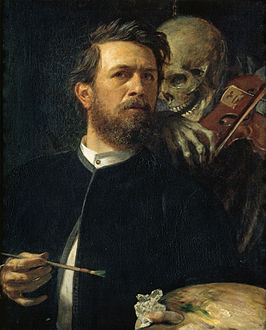- Scherzo.
- Violin solo.
Leisurely moving, without haste. Scherzo and Trio. The second movement is a scherzo that features a part for a solo violin whose strings are tuned a tone higher than usual. The violin depicts Freund Hein, (lit. “Friend Henry”) a figure from medieval German art; Hain (or Hein) is a traditional German personification of death, invented by poet Matthias Claudius.
Freund Hein is a skeleton who plays the fiddle and leads a Totentanz or “danse macabre”. According to Mahler’s widow, Alma, Mahler took inspiration for this movement from an 1872 painting by the Swiss artist Arnold Bocklin (1827-1901) entitled Self-Portrait with Death playing the Fiddle (violin solo). The scherzo represents his dance and the unusual tuning of the violin adds tension to its sound and contributes to the music’s ghostly character.
1872. Death playing the fiddle. Self-portrait by Arnold Bocklin (1827-1901).
In gemächlicher Bewegung. Ohne Hast (At a leisurely pace, unhurriedly). A shadow hangs over this Scherzo in ländler rhythm: the shrill sound of a retuned violin (each of its strings is tuned a whole tone higher) invests these pages with a suggestion of parody, although it is clear by the end of the movement that, as Mahler himself explained, ‘it wasn’t meant so seriously after all’. Originally, Mahler had headed this movement: ‘Death strikes up the dance for us; she scrapes her fiddle bizarrely and leads us up to heaven.’
Movement 2: In gemachlicher Bewegung, manuscript. [Symphonies, no. 4. Scherzo.] “3. [sic] Satz (Scherzo).” 4 pp. Full score draft of the first 33 measures. Many changes in orchestration and secondary counterpoint from final version. Solo violin part written in D major, with note “Solo Geige / um einen halben Ton höher gestimmt.” [In the final version, the violin is tuned a whole tone higher.] Given to Arnold Rosé by Mahler the day before the Vienna premiere of the symphony; signed and inscribed in upper right corner: “Erinnere dich bei diesem Blatte / an unsere gemeinschaftliche Appretur dieses Solos! / zur Zeit meiner Reconvalescenz. / Gustav.” Dated in upper left corner “11/1 [1]902.” Year 1902, 11-01-1902. Arnold Josef Rose (1863-1946).
Movement 2: In gemachlicher Bewegung, manuscript with violin solo.
Movement 2: In gemachlicher Bewegung, manuscript.
Movement 2: In gemachlicher Bewegung, manuscript, violin solo. [Symphonies, no. 4. Scherzo.] 1 p. Sheet with the first 15 measures of the solo violin part in Mahler’s hand and dated “Wien 19 29/XII 00 [i.e., 29-12-1900] / G.M.” Year 1900, 29-12-1900.
Movement 2: In gemachlicher Bewegung, manuscript.
Movement 2: In gemachlicher Bewegung, manuscript.
Listening Guide

